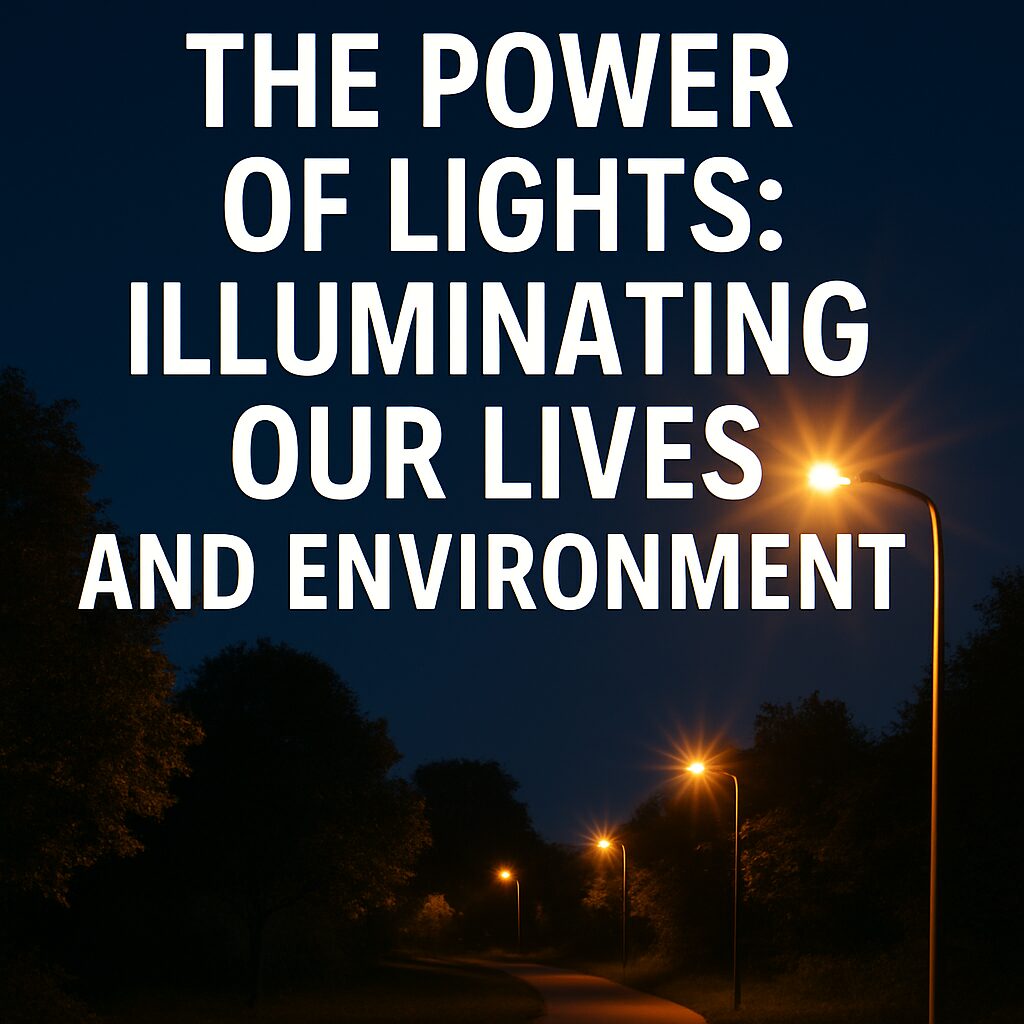Lights are more than just a source of illumination; they have evolved into essential elements of design, technology, and innovation. From their humble origins as simple candles and oil lamps to their modern use in sophisticated LED systems and smart homes, lights have always been a part of human life. Their impact on our surroundings is far-reaching, affecting everything from our daily routines to the ambiance of our spaces. This article will explore the multifaceted nature of lights, from their history and evolution to their influence on our environment and technology.
The Evolution of Lights: A Journey Through History
Lights have come a long way since they were first discovered. The earliest known forms of lighting were fire-based, such as torches and oil lamps, which provided warmth and light to early humans. Over time, humans discovered ways to improve and manipulate light sources, using materials like whale oil, kerosene, and eventually electricity.
Early Lighting Sources
Lighting was a precious commodity in ancient civilizations. In Egypt, the use of oil lamps was widespread, and the Greeks and Romans also utilized various forms of lighting, such as torches and lamps made from clay or bronze. These early lights were not only functional but also symbolic, often associated with deities or used in religious rituals.
The Birth of Electric Light
The invention of electric light in the 19th century marked a turning point in the history of lighting. Thomas Edison’s invention of the incandescent light bulb in 1879 revolutionized how we illuminate our homes, streets, and cities. This breakthrough made it possible to replace gas lamps and candles, offering a more efficient and safer means of lighting.
The Rise of LEDs and Smart Lighting
The advent of LED technology in the 20th century brought about another significant shift in the lighting industry. LEDs are more energy-efficient, longer-lasting, and environmentally friendly than traditional incandescent bulbs. This innovation has led to a surge in the use of LEDs for a wide range of applications, from household lighting to streetlights and even vehicles.
In recent years, the integration of smart technologies into lighting systems has taken things to the next level. Smart lights can now be controlled via smartphones, voice assistants, and automation systems, offering unprecedented convenience and customization.
The Importance of Lights in Our Daily Lives
Lights play a crucial role in our daily lives, influencing everything from our mood and productivity to our safety and well-being. They affect the way we perceive our surroundings and interact with others, and they can even impact our health.
Enhancing Productivity and Focus
The quality of light in our workspaces can significantly affect our productivity and focus. Bright, well-lit environments help to improve concentration and reduce eye strain, making it easier for us to perform tasks efficiently. This is why many offices and workplaces invest in high-quality lighting systems designed to enhance the work experience.
Moreover, the color temperature of light can also influence our cognitive performance. Cool white light, often used in office settings, helps to stimulate alertness and concentration, while warm yellow light is more relaxing and soothing, making it ideal for home environments.
Impact on Mood and Emotion
Lighting has a profound impact on our emotions and mental well-being. The intensity, color, and direction of light can all influence our mood. Bright, natural light is associated with feelings of happiness and energy, while dim, soft light can create a calming atmosphere that promotes relaxation.
Studies have shown that exposure to natural light during the day helps to regulate our circadian rhythms, improving sleep quality and overall health. Conversely, inadequate lighting or artificial light during the night can disrupt these rhythms, leading to issues such as insomnia and fatigue.
Lighting and Safety
The role of lights in ensuring safety cannot be overstated. Proper outdoor lighting can prevent accidents and deter criminal activity by illuminating walkways, streets, and parking lots. Well-lit areas help to reduce the risk of falls, injuries, and accidents, particularly during nighttime or in poorly lit areas.
In homes, lighting is also essential for security purposes. Motion-sensor lights and strategically placed lighting systems can provide an added layer of protection, alerting homeowners to any potential intrusions.
The Environmental Impact of Lights
As much as lights have transformed our world for the better, they also come with environmental challenges. The widespread use of energy-consuming incandescent bulbs has contributed to high energy consumption, which, in turn, has led to increased greenhouse gas emissions. However, advancements in energy-efficient lighting technologies, such as LEDs, have helped mitigate these issues.
Energy-Efficient Lighting Solutions
LED lighting has revolutionized how we approach energy consumption in the lighting industry. Unlike traditional incandescent bulbs, LEDs use a fraction of the energy to produce the same amount of light, making them much more efficient. Additionally, LEDs have a longer lifespan, reducing the need for frequent replacements and cutting down on waste.
Governments and organizations worldwide have implemented various initiatives to promote energy-efficient lighting. The adoption of energy-efficient lighting solutions has led to significant reductions in energy consumption and carbon emissions, contributing to global efforts to combat climate change.
Sustainable Lighting Practices
In addition to energy efficiency, there is growing emphasis on sustainable lighting practices. Manufacturers are now producing environmentally friendly lighting products made from recyclable materials, and efforts are being made to reduce the use of hazardous substances in the production of light bulbs.
Moreover, the growing popularity of solar-powered lights is a testament to the demand for more sustainable lighting solutions. Solar lights harness the power of the sun to provide energy-efficient illumination, reducing dependence on traditional energy sources and promoting a greener future.
The Future of Lights: What Lies Ahead?
As technology continues to advance, the future of lights holds exciting possibilities. From smart cities to personalized lighting systems, the role of lights will only become more integrated into our lives.
Smart Lighting and Automation
Smart lighting is already becoming a prominent feature of modern homes and businesses. With the rise of the Internet of Things (IoT), lighting systems can now be connected to other smart devices, allowing for seamless automation and control. Imagine a world where your lights adjust automatically based on your activities, mood, or even the time of day.
For instance, lights can be programmed to brighten in the morning, simulating natural sunlight and helping you wake up. In the evening, they could dim and shift to warmer tones to create a relaxing ambiance for winding down. The possibilities for customization are endless, and the integration of AI and machine learning will further enhance the adaptability and efficiency of lighting systems.
The Role of Light in Smart Cities
The concept of smart cities, where technology is seamlessly integrated into urban infrastructure, relies heavily on efficient and intelligent lighting solutions. Streetlights equipped with sensors can adjust their brightness based on the presence of pedestrians or vehicles, reducing energy consumption during off-peak hours.
In addition to energy savings, smart lighting systems can enhance public safety, improve traffic flow, and create more livable urban environments. As cities around the world continue to embrace smart technology, the role of lights will evolve to meet the needs of a modern, connected world.
Biophilic Lighting Design
As our understanding of the relationship between humans and the natural world grows, biophilic design is becoming an important aspect of lighting design. Biophilic lighting aims to mimic natural light patterns and incorporate elements of nature into indoor spaces.
By using lighting that simulates the natural progression of daylight, we can create environments that support our physical and emotional well-being. This approach has been shown to improve productivity, reduce stress, and enhance overall health.
Conclusion
Lights are integral to every aspect of our lives. Whether we are at work, home, or on the streets, they provide us with visibility, comfort, and security. The evolution of lighting technology, from traditional bulbs to smart, energy-efficient solutions, has transformed how we interact with our surroundings.
As we move into the future, the potential for lights to shape our environment and experiences is limitless. With innovations like smart lighting, sustainable energy sources, and biophilic designs, the possibilities are endless. Lights will continue to illuminate not only our spaces but also our imaginations, guiding us toward a brighter, more sustainable future.














